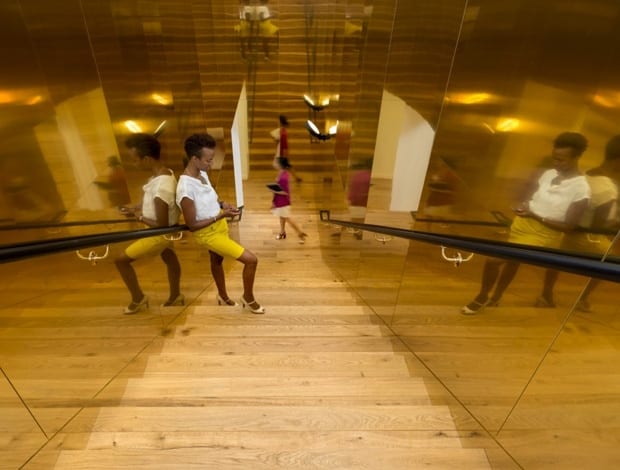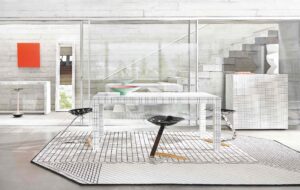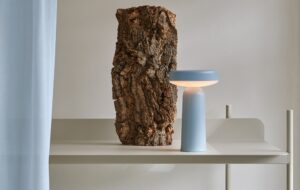 A bronze-lined staircase for “hip-hop’s first billionaire”|A large-scale Iwan Baan aerial in the engineering and R&D department|Corners are cut out to create brainstorming zones|The central café for coffee pick up throughout the day is in the core of the interior|The blue courtyard has several smaller conference and project rooms connected to it|The main lobby with a Roll & Hill chandelier|A breakout area in the all-red corridor|Meeting room overlooking the blue courtyard|Conference room with custom wallpaper by Bestor Architecture|Dutch photographer Iwan Baan’s aerial murals of the founders’ neighbourhoods|A second listening bar with David Geckeler’s Nerd bar stools||
A bronze-lined staircase for “hip-hop’s first billionaire”|A large-scale Iwan Baan aerial in the engineering and R&D department|Corners are cut out to create brainstorming zones|The central café for coffee pick up throughout the day is in the core of the interior|The blue courtyard has several smaller conference and project rooms connected to it|The main lobby with a Roll & Hill chandelier|A breakout area in the all-red corridor|Meeting room overlooking the blue courtyard|Conference room with custom wallpaper by Bestor Architecture|Dutch photographer Iwan Baan’s aerial murals of the founders’ neighbourhoods|A second listening bar with David Geckeler’s Nerd bar stools||
Completed a matter of days before Apple acquired Beats by Dre for $3m, Bestor Architecture’s design for the music streaming and hardware business’ new office campus is poles apart from Steve Jobs’ preferred all-white environments or Norman Foster’s silver donut on the outskirts of San Jose.
Designing “the best place to work in LA” is no small thing to be tasked with. Add to that the challenge of creating a series of spaces befitting hip-hop, hardcore punk and indie rock aficionados that can still work as a cohesive whole. Oh, and no clichés please. That, in essence, was Barbara Bestor’s brief for Beats by Dre’s new offices in Culver City, California.
Bestor and project designer Daniel Rabin spent two years working almost exclusively with Beats to transform premises formerly used for manufacturing dental equipment into a fitting workspace for the music streaming and hardware business.
The 10,000sq m site contains two buildings, which had to accommodate three CEOs, four executives, 14 different departments and over 600 staff members. Jimmy Iovine, who co-founded the company with Dr Dre in 2008, and president Luke Wood, shot down early concepts that encompassed the reclaimed wood and industrial steel aesthetic, stating, “This is not Beats”. Bestor says she was also keen to avoid the gimmicky “adolescent-like” interiors prevalent in Silicon Valley’s dot com industry. Instead, she wanted to design a sophisticated environment that reflects the company mindset and its focus on innovation and staying ahead of the curve.
“Beats really does represent a new path for the music business,” says Bestor. “As architects this allowed us to be slightly transgressive, design wise.
“It’s such a heterogeneous group of people, we wanted to make sure the company’s growth, optimism, sense of excitement and coolness was reflected in our environments.”
Bestor Architecture’s opening gambit was to cut skylights and two courtyards into the main building to maximise light and open up the space. A two-storey lobby followed, which runs right across the building’s short axis and can accommodate meetings with the entire company.
Open-plan working zones are pushed to the outside next to the windows and co-working zones are woven through the central area. Floor-to-ceiling whiteboards in the two-sided “project zones” allow staff to share ideas with each other, while meeting rooms look out over the atrium, further connecting the various spaces.
Having spent two decades working in a “little bunch of nests” at record companies, Wood says the office layout allows you to “see people working away” and to “understand what everyone is doing”.
The main public areas are charaterised by deep, saturated colours, such as the crimson corridor and royal blue courtyard. These are interspersed by Scandinavian-style blond wood and set off by custom op-art wallpapers and bold graphic finishes. Another standout feature is the brass-lined staircase, which Bestor says is one of her favourite aspects of the design.
As is Bestor Architecture’s custom, the firm collaborated with artists on the project. Dutch architectural photographer Iwan Baan created a series of aerial photographic murals of Silver Lake, Holmby Hills and Hollywood Hills, the neighbourhoods the Beats’ founders grew up in. These feature in ten of the conference rooms and breakout spaces. Other artworks include abstract images of freeway intersections and oil pumpjacks still in use in Baldwin Hills.
“The references are cinematic,” says Bestor, “and the idea is about view: hidden view, open view. I think it’s very romantic, like when you are walking on the ramps of the Guggenheim and getting views across the atrium.”
Attention has been lavished on an array of lighting that further distinguishes the different spaces, with designs by Tom Dixon, Castor, Roll & Hill and Iskos-Berlin. The office is furnished with Vitra workstations and products by up-and-coming designers, championed by Bestor, such as David Geckeler’s Nerd bar stool and Thomas Bentzen’s Cover chair and Around coffee table, both for Muuto.
Furniture for the executive offices includes a Corbusier couch, Alexander McQueen rug, Carl Hansen sofa, Prouvé tables and Ligne Roset Flax chairs.
Soon after Bestor and Rabin finished the redesign, Beats by Dre has been taken over by computer giant Apple for a reported $3bn in May this year. Bestor’s characterful and colourful design could not be more at odds with Apple’s clinical-white aesthetic or Norman Foster’s silver donut on the outskirts of San Jose – something she acknowledges.
“The news broke about the takeover just two or three days after Beats had moved into the new space,” she says. “[But] for us the design drivers were coming more from a lifestyle/workstyle flexibility and desire for specificity- I think that is a bit different than the whole glass transparency we associate with Apple, but they are on a spectrum together of intentionally designed experiences.”
Whether Bestor met the brief of creating “the world’s best office” remains to be seen, but Beats has made it clear that the new design is here to stay.




















